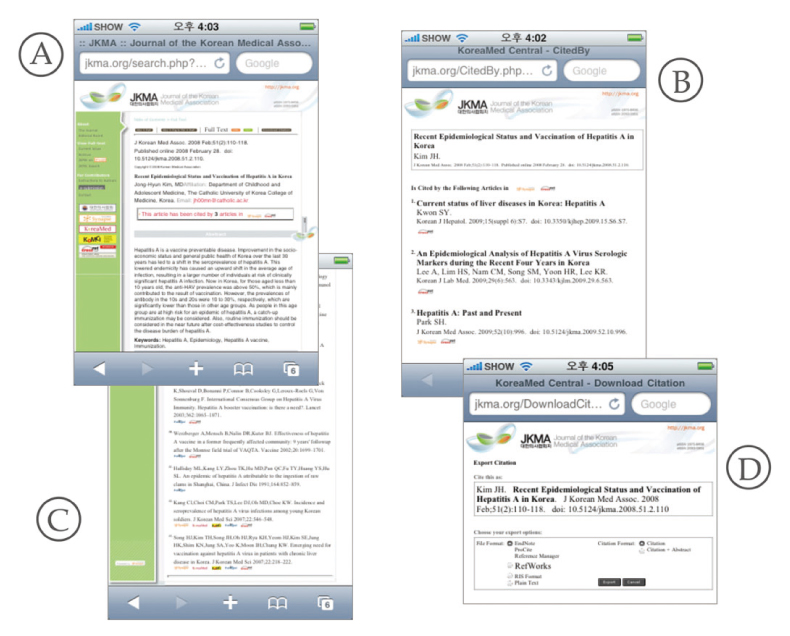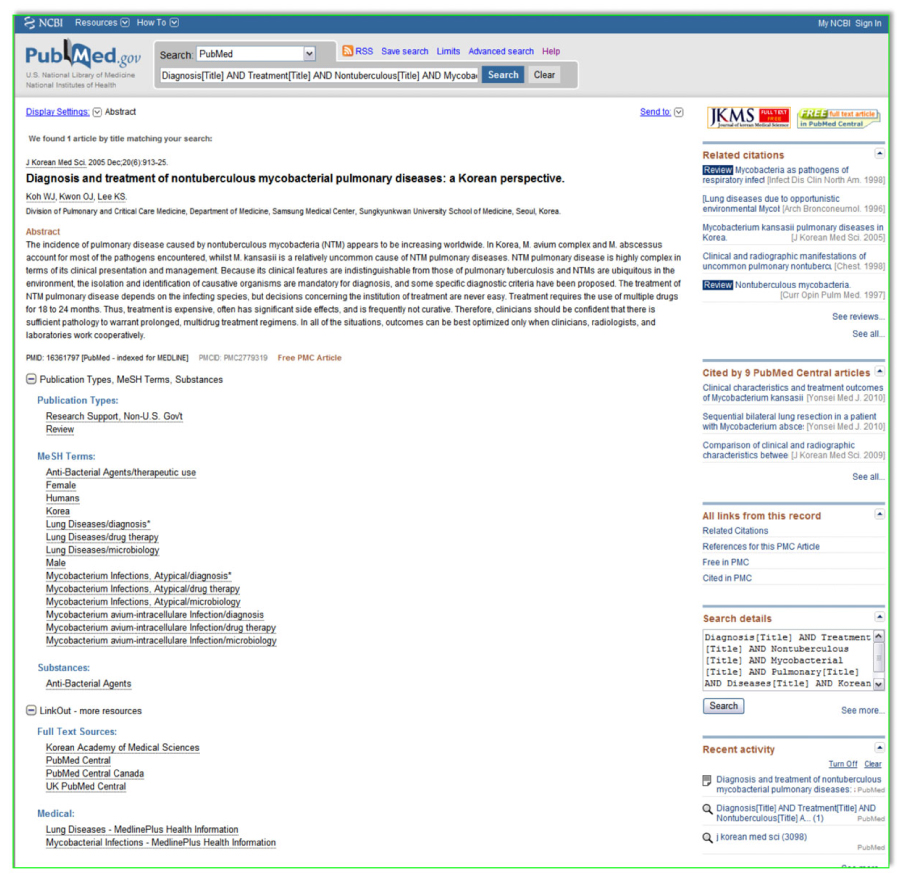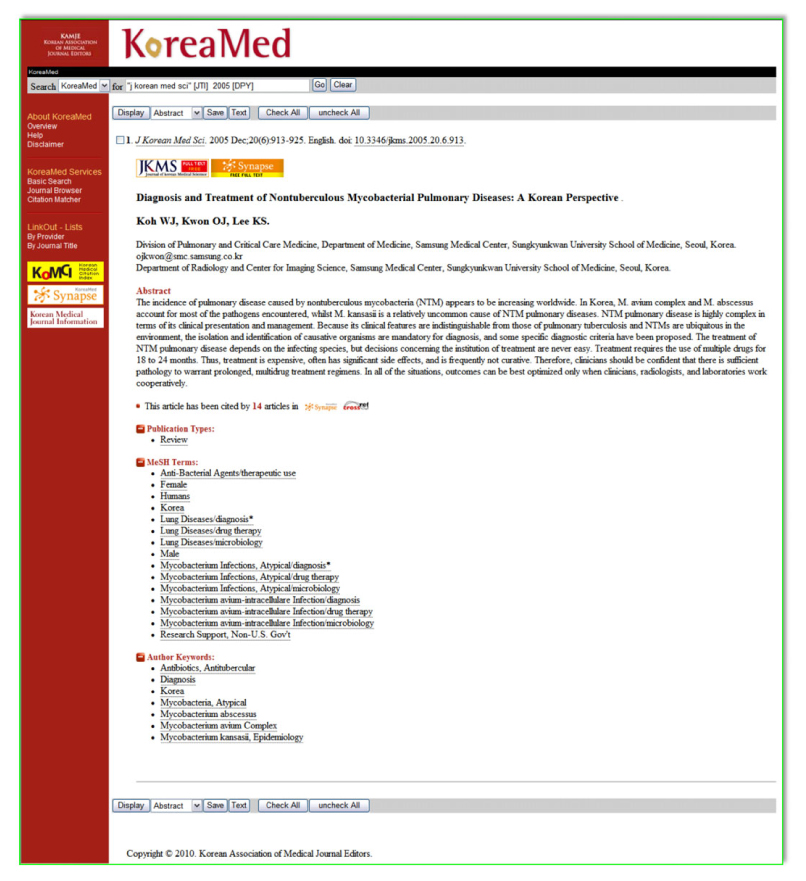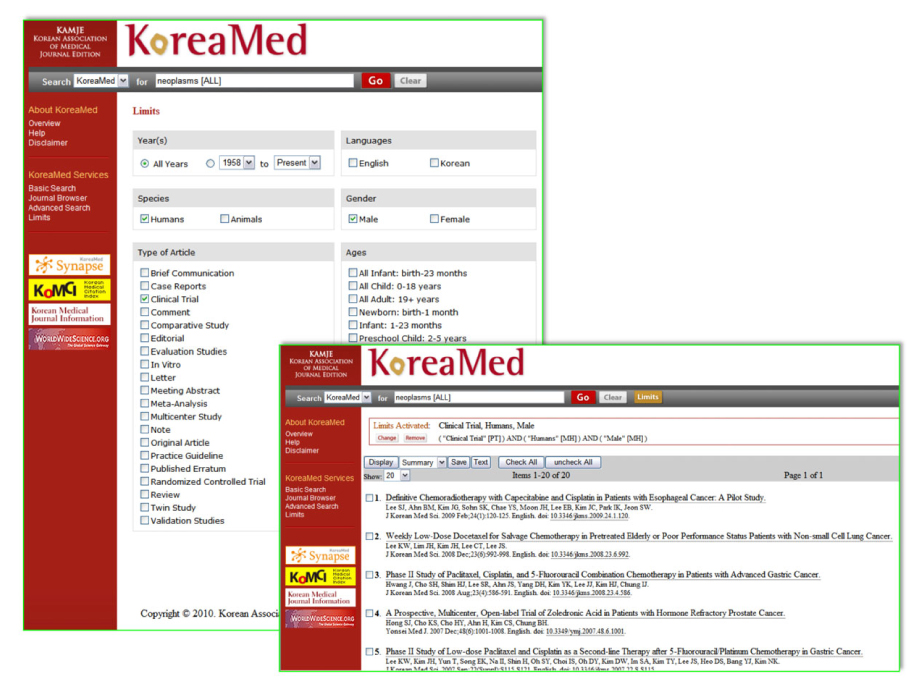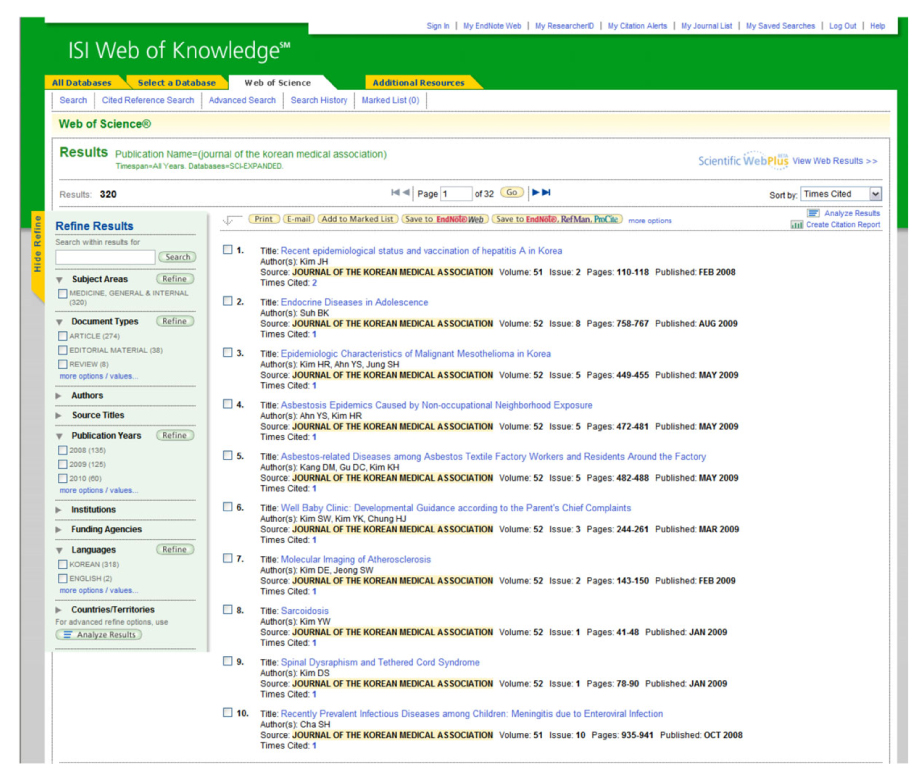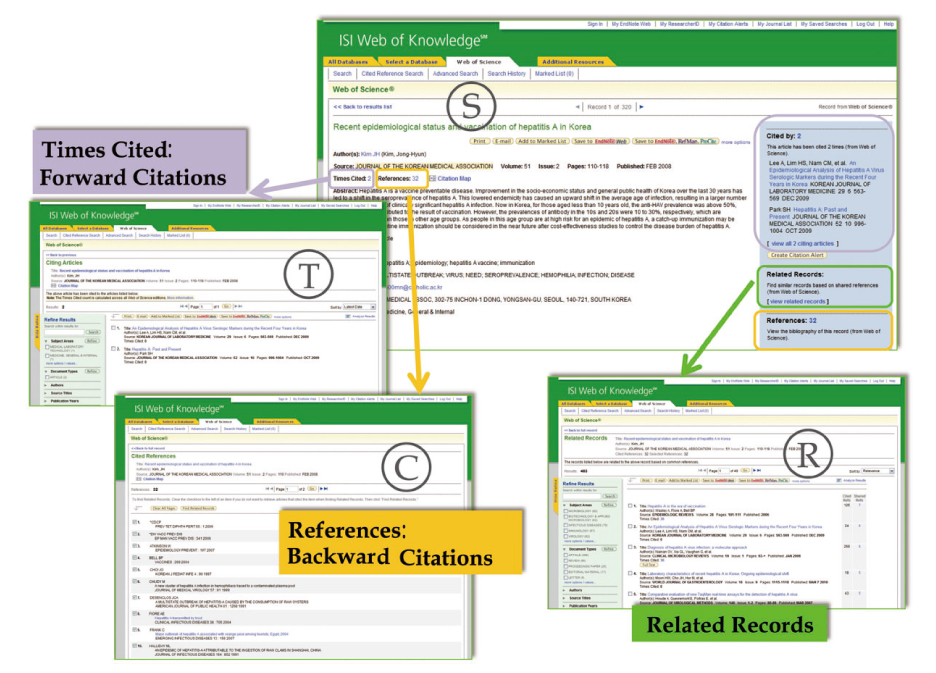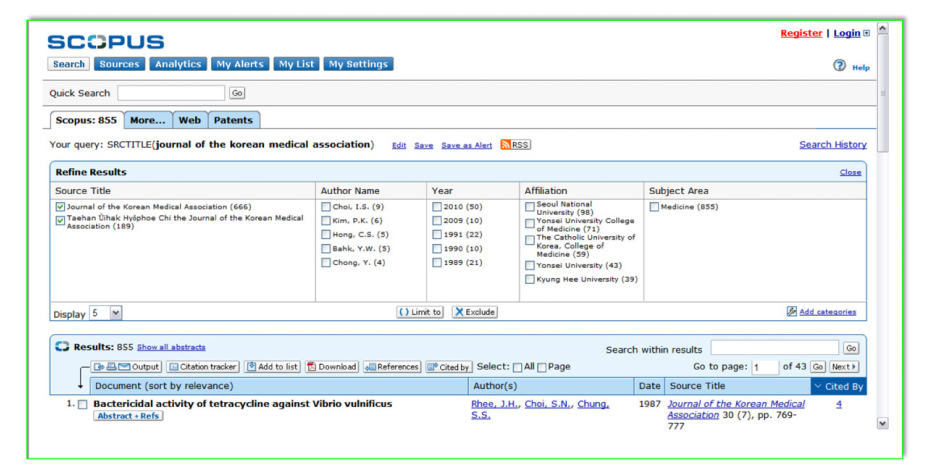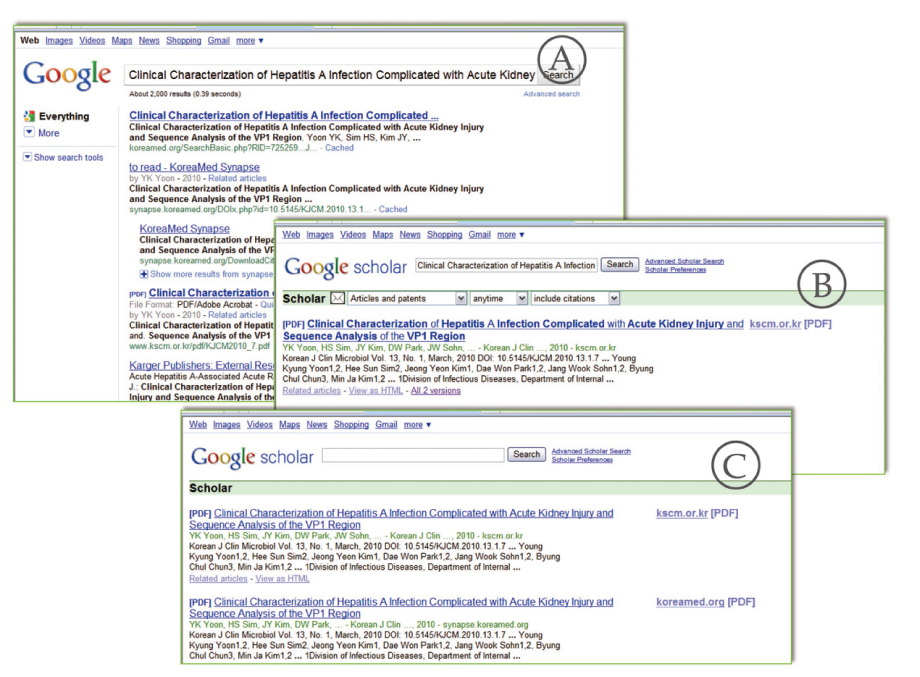J Korean Med Assoc.
2010 Aug;53(8):668-686. 10.5124/jkma.2010.53.8.668.
Medical Database Search
- Affiliations
-
- 1 Department of Library&Information Science, Sookmyung Women's University, Seoul, Korea. cslee@sookmyung.ac.kr
- KMID: 2188344
- DOI: http://doi.org/10.5124/jkma.2010.53.8.668
Abstract
- It is essential to search medical information precisely and efficiently in every aspect of medical practices and research activities. The growth of the medical literature has been tremendous in recent years, as exemplified by the annual growth of 710,000 records in MEDLINE in 2009, thus increasing the complexities of literature searching. Yet database search environments are changing toward very user-friendly ways facilitated by various hypertext linking capabilities such as "LinkOuts" to full texts and "reference linkings" among articles using Digital Object Identifiers (DOIs). Once a direct search of a keyword is initiated, a searcher can continue searching endlessly and seamlessly by simply clicking various links provided in the records retrieved. Search behaviors of researchers are changing accordingly, avoiding any complex or advanced searches. The basics of database search methods are described in this paper. A brief overview of major medical databases is given by database type to illustrate the differences in the information retrievable from such databases: MEDLINE/PubMed and KoreaMed are abstract databases; SCI/Web of Science, SCOPUS and KoMCI are citation indexes; and PubMed Central and Synapse are full text databases. Some of the advanced search features of each database are also noted: searches using MeSH terms in PubMed and KoreaMed; differences in the "related documents" algorithms of PubMed and SCI; citation analysis using "analyze results" in Web of Science and SCOPUS; and citation tracking in Synapse and PubMed. The Journal of the Korean Medical Association (JKMA) records are used for the illustration of such features.
Keyword
MeSH Terms
Figure
Reference
-
1. Data, News and Update Information. 2001. 01. 08. updated: 2010 July 6; cited 2010 July 6. Bethesda (MD): National Library of Medicine (US);Available from: http://www.nlm.nih.gov/bsd/revup/revup_pub.html#med_update.2. Key MEDLINE Indicators. 2002. 02. 07. updated: 2009 December 14; cited 2010 June 25. Bethesda (MD): National Library of Medicine (US);Available from: http://www.nlm.nih.gov/bsd/bsd_key.html.3. Detailed Indexing Statistics: 1965-2009. 2003. 08. 05. updated: 2010 March 25; cited 2010 June 25. Bethesda (MD): National Library of Medicine (US);Available from: http://www.nlm.nih.gov/bsd/index_stats_comp.html.4. Number of MEDLINE Searches. 2000. 01. 01. updated: 2008 March 6; cited 2010 June 25. Bethesda (MD): National Library of Medicine (US);Available from: http://www.nlm.nih.gov/bsd/medline_growth.html.5. Number of PubMed Searches. 2009. 11. 16. cited 2010 June 25. Bethesda (MD): National Library of Medicine (US);Available from: http://www.ncbi.nlm.nih.gov/About/tools/restable_stat_pubmed.html. http://www.ncbi.nlm.nih.gov/About/tools/restable_stat_pubmeddata.html.6. Palmer CL, Teffeau LC, Pirmann CM. Scholarly Information Practices in the Online Environment: Themes from the Literature and Implications for Library Service Development. Report commissioned by OCLC Research. 2009. Dublin, Ohio: OCLC Research;57. Available from: http://www.oclc.org/programs/publications/reports/2009-02.pdf.7. PubMed Now Using the Redesigned Interface. 2009. 10. 27. cited 2010 June 25. Bethesda (MD): National Library of Medicine (US);Available from: http://www.nlm.nih.gov/pubs/techbull/so09/so09_pm_now_redesign.html.8. Morris S. Getting Started in Electronic Publishing. 2006. 5th ed. International Network for the Availability of Scientific Publications (INASP);25. Available from: http://www.inasp.info/file/4f27e4469395717484b2d9581e20016a/book-getting-started-in-electronic-publishing.html.9. PubMed Tutorial. 2001. 03. 20. updated: 2010 June 9; cited 2010 June 25. Bethesda (MD): National Library of Medicine (US);Available from: http://www.nlm.nih.gov/bsd/disted/pubmedtutorial/.10. Number of Titles Currently Indexed for Index Medicus and MEDLINE on PubMed. 2002. 10. 31. updated: 2010 April 8; cited 2010 June 25. Bethesda (MD): National Library of Medicine (US);Available from: http://www.nlm.nih.gov/bsd/num_titles.html.11. Fact Sheet: MEDLINE. 2004. 11. 17. updated: 2010 June 2; cited 2010 June 25. Bethesda (MD): National Library of Medicine (US);Available from: http://www.nlm.nih.gov/pubs/factsheets/medline.html.12. PMC Overview. 2008. 09. 26. cited 2010 June 25. Bethesda (MD): National Library of Medicine (US);Available from: http://www.ncbi.nlm.nih.gov/pmc/about/intro.html.13. NIH Public Access Policy Details. 2008. cited 2010 June 25. Bethesda (MD): National Library of Medicine (US);Available from: http://publicaccess.nih.gov/policy.htm.14. Fact Sheet: What's the Difference Between MEDLINE and PubMed? 2002. 07. 10. updated: 2010 April 9; cited 2010 June 25. Bethesda (MD): National Library of Medicine (US);Available from: http://www.nlm.nih.gov/pubs/factsheets/dif_med_pub.html.15. Fact Sheet: PubMed, MEDLINE Retrieval on the World Wide Web. 2002. 06. 07. updated: 2010 March 1; cited 2010 June 25. Bethesda (MD): National Library of Medicine (US);Available from: http://www.nlm.nih.gov/pubs/factsheets/pubmed.html.16. Computation of Related Citations. 2005. updated: 2008 June 28; cited 2010 June 25. Bethesda (MD): National Library of Medicine (US);Available from: http://www.ncbi.nlm.nih.gov/bookshelf/br.fcgi?book=helppubmed&part=pubmedhelp#pubmedhelp.Computation_of_Related_Citati.17. PubMed Help. 2005. updated: 2008 June 28; cited 2010 June 25. Bethesda (MD): National Library of Medicine (US);Available from: http://www.ncbi.nlm.nih.gov/bookshelf/br.fcgi?book=helppubmed&part=pubmedhelp.18. MeSH Browser. 2009. updated: 2009 August 28; cited 2010 June 25. Bethesda (MD): National Library of Medicine (US);Available from: http://www.nlm.nih.gov/mesh/MBrowser.html.19. KoreaMed Help. 2005. cited 2010 June 25. Seoul: Korean Association of Medical Journal Editors;Available from: http://www.koreamed.org/Help.php.20. KoreaMed Overview. 2005. cited 2010 June 25. Seoul: Korean Association of Medical Journal Editors;Available from: http://www.koreamed.org/Overview.php.21. Synapse Overview. 2007. cited 2010 June 25. Seoul: Korean Association of Medical Journal Editors;Available from: http://synapse.koreamed.org/Overview.php.22. Synapse Help. 2007. cited 2010 June 25. Seoul: Korean Association of Medical Journal Editors;Available from: http://synapse.koreamed.org/Help.php.23. Lee CS. Bibliometric Analysis of the Korean Journal of Parasitology: Measured from SCI, PubMed, Scopus, and Synapse Databases. Korean J Parasitol. 2009. 47:S155–S167. DOI:10.3347/kjp.2009.47.S.S155.
Article24. Journal Selection Process. 2010. cited 2010 June 25. New York: Thomson Reuters;Available from: http://science.thomsonreuters.com/mjl/selection/.25. The Thomson Reuters Journal Selection Process. 2010. cited 2010 June 25. New York: Thomson Reuters;Available from: http://thomsonreuters.com/products_services/science/free/essays/journal_selection_process/.26. Web of Science Databases. 2009. updated 2009 February 17; cited 2010 June 25. New York: Thomson Reuters;Available from: http://images.isiknowledge.com/WOK46/help/WOS/h_database.html#sci.27. Web of Science Related Records. 2009. modified 2009 August 19; cited 2010 June 25. New York: Thomson Reuters;Available from: http://images.isiknowledge.com/WOKRS49B3/help/WOS/h_summrr.html.28. About Journal Citation Reports. 2010. modified 2010 June 10; cited 2010 June 25. New York: Thomson Reuters;Available from: http://admin-apps.isiknowledge.com/JCR/help/h_jcrabout.htm.29. About KoMCI. 2009. cited 2010 June 25. Seoul: Korean Academy of Medical Sciences;Available from: http://www.koreamed.org/Help.php.30. SCOPUS in Detail. 2010. cited 2010 June 25. Amsterdam: Elsevier;Available from: http://info.scopus.com/scopus-in-detail/content-coverage-guide/.31. Perceptions of Libraries and Information Resources: A Report to the OCLC Membership. 2005. Dublin, Ohio: OCLC Research;290. Available from: http://www.oclc.org/reports/2005perceptions.htm.
- Full Text Links
- Actions
-
Cited
- CITED
-
- Close
- Share
- Similar articles
-
- Searching Medical Literature Effectively
- Comparison of the Utility of Korean Bibliographic Databases for Searching Domestic Literature Related to Microbiology and Infectious Diseases
- Current Status of Medical Databases in Writing Research Papers
- Web-based Y-STR Database for Haplotype Frequency Estimation and Kinship Index Calculation
- Management of oral and maxillofacial radiological images

